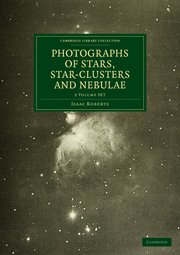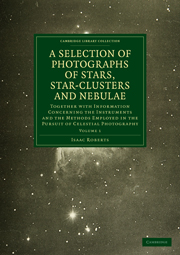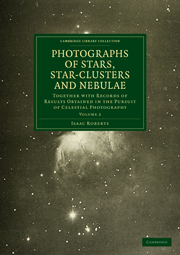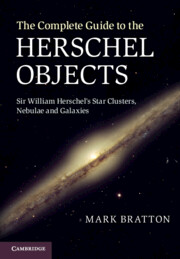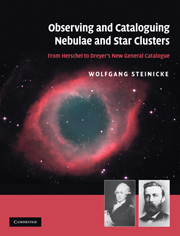Photographs of Stars, Star-Clusters and Nebulae 2 Volume Paperback Set
A geologist and fellow of the Royal Astronomical Society, Isaac Roberts (1829–1904) made significant contributions to the photography of star-clusters and nebulae. By championing reflecting rather than refracting telescopes, Roberts was able to perceive previously unnoticed star-clusters, and was the first person to identify the spiral shape of the Great Andromeda Nebula. Roberts' use of telescopes for photographing stars provided greater definition of stellar phenomena than previously used hand-drawings. Although Roberts' conclusions about the nature of the nebulae he photographed were not always correct, and sometimes misinterpreted by others, the book is significant for the possibilities it suggests for nebular photography. Published in 1893 and 1899, these volumes represent the summation of his work with his assistant W. S. Franks at his observatory in Crowborough, Sussex. Lavishly illustrated, the books contain descriptions of instruments and methodology, and Roberts' theory of the stars' origins and nature.
Product details
October 2010Multiple copy pack
9781108015240
482 pages
297 × 210 × 20 mm
0.95kg
Temporarily unavailable - available from TBC
Table of Contents
- Volume 1: Preface
- Isaac Roberts' observatory, Crowborough Hill
- Isaac Roberts' telescopes
- List of the plates
- List of the abbreviations
- 1. The negatives
- 2. Arrangement of the photographs
- 3. Epoch of the Fiducial stars (A.D. 1900)
- 4. A table for converting measurements in right ascensions into intervals of time
- 5. Illustrations of the method for determining the right ascensions and declinations of the stars
- 6. Introduction
- Utility of the photographic charts
- 7. Refractors and reflectors as photo-instruments
- 8. Requirements and adjustments of a reflector for celestial photography
- 9. Collimation of the mirror
- 10. Essentials of a photo-telescope
- 11. Method for testing the stability of a photo-instrument
- 12. Photographic plates: their exposures and development
- 13. Description of the photographs and references concerning them
- 14. Deductions from the photographs. Volume 2: Preface
- List of the plates
- Instruments
- List of abbreviations adopted in this work
- 1. The negatives
- 2. Epoch of the Fiducial stars, A.D. 1900
- 3. Table for converting the measured right ascensions
- 4. Deterioration of the negatives
- 5. Effects of atmospheric glare and of diffraction upon the films of photographic plates
- 6. Arrangement of the plates
- 7. Method for micro-puncturing the photographic discs of stars on plates
- 8. Star catalogues and photographic charts
- 9. Duration of the effective exposures given to photographic plates in the 20-inch reflector
- 10. Are the millions of stars and the numerous nebulosities limited in number and extent
- 11. The evolution of stellar systems
- 12. Inferences suggested by examination of the photographs
- 13. Description of the photographs
- 14. M.31. Andromedae
- 15. M.99 Virginis
- 16. M.51 Canum Venaticorum
- 17. Region of 7 Cassiopeiae
- 18. Nebulae in the Pleiades
- 19. M.42. Orionis
- 20. General conclusions concerning the evolution of stellar systems.

